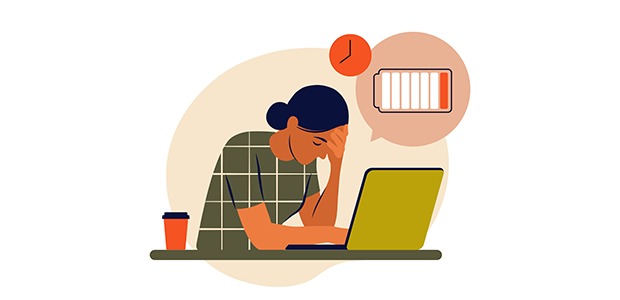
Beat the burnout: tips to transform your office culture
A recent report by the Chartered Institute for Personnel and Development (CIPD) has revealed that sick days at work have reached their highest level in ten years. The average number of sick days taken by employees in the past year rose to nearly eight, up from 5.8 days prior to the pandemic.
Additionally, research by YouGov for Mental Health UK found that one in five workers requested time off due to poor mental health caused by workplace pressure or stress in the past year.
To combat these trends, it is essential to consider how the office environment can be adapted to reduce stress, burnout, and sickness among staff.
Insights from experts at Savoy Stewart offer several strategies for creating a healthier workplace:
Managing workplace stress
Stress and job burnout are leading causes of absenteeism, making it crucial to identify and address workplace stressors. High-stress situations, such as unreasonable deadlines, unclear expectations, or unmanageable workloads, can trigger the ‘fight or flight’ response, a survival mechanism that, when prolonged, can lead to burnout or chronic stress.
Georgina Sturmer, MBACP Counsellor, advises: “Employers can manage workplace stress for their staff by building a culture that acknowledges the impact that stress has on employees, and that offers an open dialogue to support employees in how they manage their stress.
“Employers can lead by example, by sharing how they are being proactive about managing their own stress levels. Asking for help, delegating work, using their annual leave, taking regular breaks during the work day. These actions all filter down to our employees – if they see senior colleagues behaving in this way, then they will know that it is acceptable to do so.”
Embracing employee boundaries
Maintaining a healthy work-life balance is essential for long-term career growth. A study by workinmind.org found that 63% of workers did unpaid overtime at least once a week, with one in three neglecting their mental health due to excessive work demands.
Georgina Sturmer adds: “The pressure to be contactable and responsive 24/7 is a major contributor to workplace stress. It makes it hard for us to wind down, which makes us less productive and more prone to stress and burnout.
“Have defined times when you expect staff to be ‘on’ and make sure that there isn’t pressure for them to be available outside of these hours. As an employer you can lead by example. Consider having separate devices for work and for leisure, or at least try to resist the urge to send work messages outside of hours.”
Increasing staff flexibility
Flexible working arrangements can significantly reduce absenteeism by enabling employees to better balance work and personal responsibilities. A study by the National Library of Medicine found that flexible working options, such as working from home or adjusting work schedules, increased job satisfaction by over 60%.
Offering flexible working conditions helps reduce job stress and improve overall job satisfaction. By allowing staff to manage their own schedules and work environments, employers can provide a sense of control and freedom, contributing to a healthier work-life balance.
Enhancing wellbeing benefits
According to the CIPD, one-third of organisations have increased their budget for wellbeing benefits since the pandemic. However, this may not be sufficient. Perci Health reports that while around 25% of UK employees have a physical health condition, less than half feel supported by their employer.
Wellbeing benefits, such as health insurance and gym memberships, not only serve as preventive measures but also help employees recover after sickness. It is important to offer benefits that employees truly value and to seek their input on what they need most. Covering various aspects of wellbeing, including physical, mental, financial, and overall health, can help reduce stress and burnout.
Georgina Sturmer advises: “Ask your staff what they need. They might seek traditional benefits, like access to leisure facilities or additional annual leave. But they might also benefit from more flexible working patterns, or opportunities to have fun with their colleagues. Or they might be looking for additional mental health support, through workplace counselling options or a programme of Mental Health First Aid.”
Creating a comfortable office environment
Office design can play a key role in reducing stress. Providing break-out spaces allows staff to take meetings or breaks in different environments, catering to their need for concentration or creativity. In open-plan offices, it’s crucial to offer quiet zones where employees can escape the hustle and bustle.
Simple additions such as adding colour, greenery, and natural light, along with providing stress-relief tools like stress balls and desktop organisers, can contribute to a healthier atmosphere and reduce stress.
Training managers to handle absenteeism
Line managers play a pivotal role in managing staff absenteeism, yet many lack confidence in addressing sensitive issues like mental health. The CIPD found that less than 40% of HR respondents believe managers are equipped to handle such discussions.
Providing training in absence management can give managers the tools they need to support staff effectively, from conducting return-to-work interviews to recognising early signs of mental ill health.
Georgina Sturmer emphasises the importance of compassion when dealing with staff calling in sick due to stress or burnout: “It can take an enormous amount of courage to tell our workplace that we can’t come into work due to stress or burnout. Be kind and compassionate towards them, and make sure that they are clear on your company’s policy for these types of absences. Respect their confidentiality in the same way as you would with any other type of absence. Make sure that they know where to go if they need support with their mental health, they can see their GP and access help through Samaritans and SHOUT. And take it as an opportunity to learn. Is there anything that you can improve in the workplace, to avoid this situation happening again in the future.”


